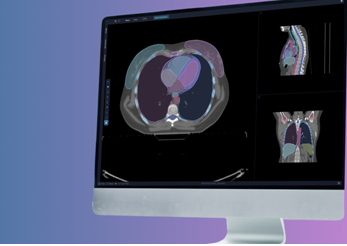Here’s what you need to know: AI contouring technology can transform your radiation oncology department by reducing contouring time by up to 95%, significantly increasing the accuracy, and enabling faster treatment delivery while addressing critical workforce shortages.
You’re probably wondering whether AI contouring is worth the investment for your department. This guide explores how artificial intelligence revolutionizes radiation therapy treatment planning, examines specific benefits for your workflows, and helps you select the right solution for your clinic.
What is AI contouring in radiation oncology?
AI contouring represents a breakthrough approach to one of radiation therapy’s most critical yet time-intensive processes: delineating organs-at-risk (OARs), clinical target volumes and gross target volumes on medical imaging scans. Traditional manual contouring requires radiation oncologists to outline anatomical structures slice by slice, a subjective process that’s dependent on user experience and leads to problematic inter-observer variations.
Deep learning algorithms have revolutionized this landscape by automatically generating precise anatomical contours within minutes rather than hours. AI systems utilize sophisticated neural networks trained on thousands of expert-validated cases to recognize anatomical patterns across different imaging modalities. These systems can accurately identify complex structures including lymph node regions, brainstem components, and irregular tumor volumes that traditionally challenge even experienced practitioners.
What sets contemporary AI contouring apart from earlier attempts? It’s the ability to handle anatomical variations, surgical changes, and imaging artifacts while integrating seamlessly with existing treatment planning systems through DICOM compatibility. Advanced systems now incorporate active learning capabilities, allowing them to improve performance based on institutional preferences and medical doctors feedback.
Benefits for Radiation Oncology Departments
AI contouring technology delivers transformative advantages across multiple dimensions of radiotherapy oncology department operations. Here are the key benefits you can expect:
1. Substantial Time Reduction and Workflow Efficiency
The most immediately noticeable benefit involves substantial time savings in treatment planning workflows. Clinical studies demonstrate that AI contouring systems save an average of 36 to 45 minutes per case across all anatomical structures, with some implementations showing reductions of up to 95% in contouring time per patient compared to manual approaches.
2. Enhanced Accuracy and Consistency
AI contouring systems deliver superior accuracy compared to traditional manual approaches. Radiation oncologists using AI-based tools generate more accurate contours for treatment planning than those using conventional tools, which directly impacts treatment quality and patient outcomes.
Perhaps more importantly, AI systems address the persistent challenge of inter-observer variability. Complex anatomical regions like head and neck structures achieve much more consistent results through AI approaches.
3. Standardization Across Guidelines and Institutions
AI contouring enables guideline-based standardization that addresses one of radiation oncology’s most persistent challenges. Advanced AI platforms train models with peer-reviewed contouring data according to 25+ consensus guidelines, ensuring consistent application of established standards.
This standardization proves especially valuable for multi-institutional studies, training programs, quality assurance programs, and clinical trials. AI systems help establish institutional norms that align with international guidelines while accommodating local preferences through customizable parameters.
4. Workforce Optimization and Professional Development
The global shortage of qualified radiation oncology professionals makes workforce optimization critical for department sustainability. It was estimated that there would be a global dearth of over 29,000 radiation therapists, 9,000 medical physicists, and 12,000 radiation oncologists.
AI contouring directly addresses this challenge by enabling existing staff to handle increased patient volumes without proportional workforce increases. Time savings allow radiation oncologists to spend more time on higher-value activities including direct patient consultation, complex treatment planning decisions, quality assurance, research, and multidisciplinary team collaboration.
5. Improved Patient Access and Outcomes
AI contouring improvements translate directly into better patient care through reduced treatment delays, enhanced treatment quality, and improved global access. Delays in radiation therapy start can negatively affect clinical outcomes for some cancers due to repopulation and tumor burden increase.
More accurate and consistent contouring leads to better dose distribution, potentially improving local control while reducing normal tissue toxicity.
6. Cost-Effectiveness and Resource Management
AI contouring delivers measurable economic benefits through multiple pathways. Staff productivity gets a significant boost as reduced contouring time leads to substantial cost savings by enabling existing staff to handle larger patient volumes. Training costs decrease because AI systems reduce the extensive training time typically required for manual contouring proficiency.
Quality cost avoidance pays dividends through more consistent, accurate contouring that reduces the likelihood of plan revisions, replanning costs, and potential treatment-related complications. Equipment utilization improves dramatically as faster treatment planning enables better utilization of expensive linear accelerators and imaging equipment.
What AI Contouring software should oncology departments choose?
Selecting the optimal AI contouring solution requires careful evaluation of accuracy, workflow integration, technical support, and long-term scalability. Based on comprehensive clinical evaluations and real-world implementations, Synaptiq contouring platform, Mediq RT, emerges as a particularly compelling choice for oncology departments seeking cutting-edge AI contouring capabilities. The platform’s unique Active Intelligence capability represents a breakthrough in interactive AI technology, enabling medical doctors to delineate GTVs using an interactive approach. Currently, Synaptiq is the only company on the market offering such capability. Moreover, the platform successfully handles contouring for 250+ organs across all cancer sites and has already been implemented in multiple medical radiotherapy clinics with proven real-world results.
Conclusion
AI contouring is no longer a “nice-to-have” for radiation oncology, it’s quickly becoming a necessity. Departments that adopt it can slash planning time, standardize care, optimize scarce staff resources, and deliver faster, higher-quality treatment to more patients. The technology is mature, clinically validated, and already transforming leading oncology centers worldwide.
If your department is serious about scaling capacity, improving outcomes, and staying ahead of the curve, the time to evaluate AI contouring solutions for your radiation oncology department is now.
